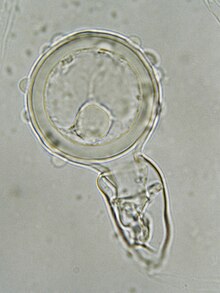| Phytophthora cambivora | |
|---|---|

| |
|
Scientific classification
| |
| Domain: | Eukaryota |
| Clade: | Diaphoretickes |
| Clade: | SAR |
| Clade: | Stramenopiles |
| Phylum: | Oomycota |
| Order: | Peronosporales |
| Family: | Peronosporaceae |
| Genus: | Phytophthora |
| Species: | P. × cambivora
|
| Binomial name | |
| Phytophthora × cambivora | |
| Synonyms | |
| |

Phytophthora × cambivora is a plant pathogen that causes ink disease in European chestnut trees ( Castanea sativa). Ink disease, also caused by Phytophthora cinnamomi, is thought to have been present in Europe since the 18th century, and causes chestnut trees to wilt and die; major epidemics occurred during the 19th and 20th centuries. P. cinnamomi and P. × cambivora are now present throughout Europe since the 1990s. Ink disease has resurged, often causing high mortality of trees, particularly in Portugal, Italy, and France. [1] It has also been isolated from a number of different species since the 1990s, including:
- Golden chinquapin trees, ( Chrysolepis chrysophylla) in Oregon, United States [2]
- Rhododendron and Pieris species in North Carolina [3]
- Noble fir trees ( Abies procera) in Norway [4]
- Beech trees ( Fagus sylvatica) in Italy [5] and Germany. [6]
Some species of mycorrhiza (including Amanita muscaria, Suillellus luridus, and Hebeloma radicosum) may provide protection from P. cambivora in European chestnuts. [7]
Phytophthora × cambivora is a hybrid. [8]
See also
References
- ^ Robin, Cécile; Olivier Morel; Anna-Maria Vettraino; Charikleia Perlerou; Stephanos Diamandis; Andrea Vannini (1 May 2006). "Genetic variation in susceptibility to Phytophthora cambivora in European chestnut (Castanea sativa)". Forest Ecology and Management. 226 (1–3): 199–207. doi: 10.1016/j.foreco.2006.01.035.
- ^ Saavedra, A; E. M. Hansen; D. J. Goheen (19 November 2007). "Phytophthora cambivora in Oregon and its pathogenicity to Chrysolepis chrysophylla". Forest Pathology. 37 (6): 409–419. doi: 10.1111/j.1439-0329.2007.00515.x. Archived from the original on 5 January 2013. Retrieved 9 July 2009.
- ^ Hwang, J; Warfield, CY; Benson, DM (June 2006). "Phytophthora cambivora, a new dieback pathogen of Rhododendron and Pieris in North Carolina". Phytopathology. 96 (6): supplement pages 185–186. Archived from the original on 7 March 2012. Retrieved 9 July 2009.
- ^ Talgø, V; M. Herrero; B. Toppe; S. Klemsdal; A. Stensvand (May 2006). "First Report of Root Rot and Stem Canker Caused by Phytophthora cambivora on Noble Fir (Abies procera) for Bough Production in Norway". Plant Disease. 90 (5): 682. doi: 10.1094/PD-90-0682B. PMID 30781155.
- ^ Belisario, A; M. Maccaroni; M. Vettorazzo (October 2006). "First Report of Phytophthora cambivora Causing Bleeding Cankers and Dieback on Beech (Fagus sylvatica) in Italy". Plant Disease. 90 (10): 1362. doi: 10.1094/PD-90-1362C. PMID 30780960.
-
^ Hartmann, G; Blank, R; Kunca, A. "Collar rot of Fagus sylvatica caused by Phytophthora cambivora - type of damage, endangered sites and susceptible hosts in Northwestern Germany".
{{ cite journal}}: Cite journal requires|journal=( help) - ^ Landi, L; Mosca, M; Branzanti, M.B. (27–29 March 2006). "Interactions between mycorrhizic fungi and Phytophthora cambivora agent of ink disease in chestnut [Castanea sativa Mill.]". Italian Plant Protection Association. Biennial Meeting. Retrieved 9 July 2009.[ permanent dead link]
- ^ Jung, T.; Pérez-Sierra, A.; Durán, A.; Jung, M. Horta; Balci, Y.; Scanu, B. (2018). "Canker and decline diseases caused by soil- and airborne Phytophthora species in forests and woodlands". Persoonia – Molecular Phylogeny and Evolution of Fungi. 40: 182–220. doi: 10.3767/persoonia.2018.40.08. PMC 6146643. PMID 30505001. S2CID 54167832. Yang, Xiao; Tyler, Brett M.; Hong, Chuanxue (2017). "An expanded phylogeny for the genus Phytophthora". IMA Fungus. 8 (2): 355–384. doi: 10.5598/imafungus.2017.08.02.09. PMC 5729717. PMID 29242780. S2CID 9386776. These reviews cite this research. Jung, T.; Jung, M.H.; Scanu, B.; Seress, D.; Kovács, G.M.; Maia, C.; Pérez-Sierra, A.; Chang, T.-T.; Chandelier, A.; Heungens, K.; Van Poucke, K.; Abad-Campos, P.; Léon, M.; Cacciola, S.O.; Bakonyi, J. (2017). "Six new Phytophthora species from ITS Clade 7a including two sexually functional heterothallic hybrid species detected in natural ecosystems in Taiwan". Persoonia – Molecular Phylogeny and Evolution of Fungi. 38: 100–135. doi: 10.3767/003158517X693615. PMC 5645180. PMID 29151629. S2CID 12341727.